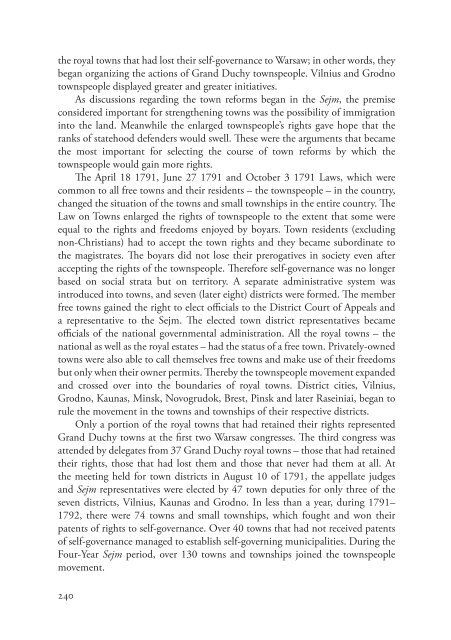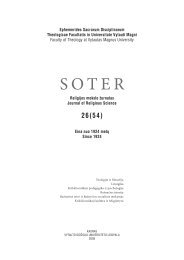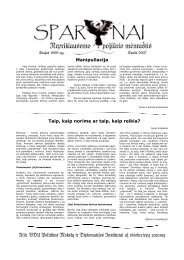Untitled - Vytauto Didžiojo universitetas
Untitled - Vytauto Didžiojo universitetas
Untitled - Vytauto Didžiojo universitetas
You also want an ePaper? Increase the reach of your titles
YUMPU automatically turns print PDFs into web optimized ePapers that Google loves.
the royal towns that had lost their self-governance to Warsaw; in other words, they<br />
began organizing the actions of Grand Duchy townspeople. Vilnius and Grodno<br />
townspeople displayed greater and greater initiatives.<br />
As discussions regarding the town reforms began in the Sejm, the premise<br />
considered important for strengthening towns was the possibility of immigration<br />
into the land. Meanwhile the enlarged townspeople’s rights gave hope that the<br />
ranks of statehood defenders would swell. These were the arguments that became<br />
the most important for selecting the course of town reforms by which the<br />
townspeople would gain more rights.<br />
The April 18 1791, June 27 1791 and October 3 1791 Laws, which were<br />
common to all free towns and their residents – the townspeople – in the country,<br />
changed the situation of the towns and small townships in the entire country. The<br />
Law on Towns enlarged the rights of townspeople to the extent that some were<br />
equal to the rights and freedoms enjoyed by boyars. Town residents (excluding<br />
non-Christians) had to accept the town rights and they became subordinate to<br />
the magistrates. The boyars did not lose their prerogatives in society even after<br />
accepting the rights of the townspeople. Therefore self-governance was no longer<br />
based on social strata but on territory. A separate administrative system was<br />
introduced into towns, and seven (later eight) districts were formed. The member<br />
free towns gained the right to elect officials to the District Court of Appeals and<br />
a representative to the Sejm. The elected town district representatives became<br />
officials of the national governmental administration. All the royal towns – the<br />
national as well as the royal estates – had the status of a free town. Privately-owned<br />
towns were also able to call themselves free towns and make use of their freedoms<br />
but only when their owner permits. Thereby the townspeople movement expanded<br />
and crossed over into the boundaries of royal towns. District cities, Vilnius,<br />
Grodno, Kaunas, Minsk, Novogrudok, Brest, Pinsk and later Raseiniai, began to<br />
rule the movement in the towns and townships of their respective districts.<br />
Only a portion of the royal towns that had retained their rights represented<br />
Grand Duchy towns at the first two Warsaw congresses. The third congress was<br />
attended by delegates from 37 Grand Duchy royal towns – those that had retained<br />
their rights, those that had lost them and those that never had them at all. At<br />
the meeting held for town districts in August 10 of 1791, the appellate judges<br />
and Sejm representatives were elected by 47 town deputies for only three of the<br />
seven districts, Vilnius, Kaunas and Grodno. In less than a year, during 1791–<br />
1792, there were 74 towns and small townships, which fought and won their<br />
patents of rights to self-governance. Over 40 towns that had not received patents<br />
of self-governance managed to establish self-governing municipalities. During the<br />
Four-Year Sejm period, over 130 towns and townships joined the townspeople<br />
movement.<br />
240





